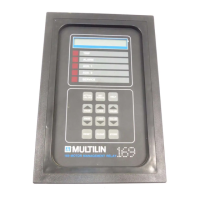
Do you have a question about the GE 169 and is the answer not in the manual?
Lists manual changes across software revisions.
Explains the need for advanced motor protection.
Details the capabilities and models of the 169 relay.
Lists common uses and benefits of the 169 relay.
Details electrical, mechanical, and environmental specifications.
Information on how to specify and order the 169 relay.
Provides physical measurements, diagrams, and instructions for mounting.
Outlines input/output connections, wiring diagrams, and terminal functions.
Details control power, CTs, RTDs, relay outputs, and communication ports.
Covers Emergency Restart, External Reset, Serial Comms, Display, and Drawout version.
Explains keypad functions, indicators, and different display modes.
How to navigate and use Actual Values, Setpoints, and Help modes.
Covers configuration of CTs, overload curves, unbalance, ground fault, RTDs, etc.
Details thermal memory, restart, self-test, statistical data, and factory setpoints.
Methods for verifying relay operation and functionality.
Testing current input functions and ground fault detection.
Verifying RTD inputs and relay behavior during power interruptions.
Testing analog output and performing routine maintenance checks.
Overview of the relay's internal hardware components.
Explanation of the relay's software architecture and operational flow.
Examples of powering the relay and ensuring motor trip during power loss.
Practical use of a setpoint for coordinating thermal limit curves.
Definitions of key terms used throughout the manual.